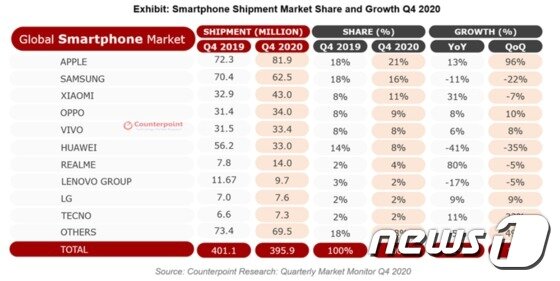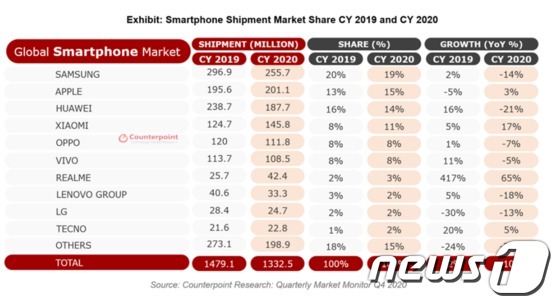 |
| Global smartphone market share in 2020 announced by Counterpoint Research, a global market research firm. <출처-카운터포인트리서치 제공> © News1 |
Samsung Electronics took the first place in the global smartphone market last year. However, competition with Apple in the flagship smartphone and Chinese companies in the mid- to low-end smartphone market is intensifying.
According to a market monitor released by Counterpoint Research, a global market research firm, on the 29th, Samsung Electronics ranked first in the global smartphone market last year with 19% share.
However, with fierce competition between Apple and Chinese manufacturers, the 20% share line collapsed in 10 years. In addition, shipments were also 255.7 million units, down 14% from the previous year. In 2019, Samsung Electronics’ smartphone shipments were 296.90 million units.
In the fourth quarter of last year, Apple, which ranked second with 15% market share, succeeded in hitting the box office with the first 5G smartphone’iPhone 12′ amid strong sales of the iPhone 11, and 3 from 18% market share last year to 21% share. As it rose by percentage point (P), it beat Samsung and took the top spot.
Apple’s smartphone shipments in the fourth quarter were 81.9 million units, up 96% year-on-year. In the wake of Apple’s growth, global smartphone shipments in the fourth quarter reached 396 million units, up 8% QoQ.
In the mid- to low-end smartphone market, Samsung Electronics’ A-series performed well, but competition is intensifying as Chinese companies hit the ground.
Huawei maintained its third place in market share last year, doing well in the Chinese market despite a severe shortage of parts due to US sanctions. However, as of the fourth quarter, Huawei’s market share fell from 14% last year to 8%, falling to 6th place.
Instead, other Chinese manufacturers occupied Huawei’s vacancy. Xiaomi shipped 43 million smartphones, ranking 3rd with 11%, an increase of 3 percentage points over the previous year. In addition, Oppo shipped 34 million units, ranking 4th with a 9% market share, and Vivo shipping 33.4 million units, ranking 5th with 8% market share.
Aman Chaudhari, a researcher at Counterpoint Research, said, “Opo is actively targeting overseas markets in Europe, the Middle East, and Africa, and is continuing its growth. In particular, taking advantage of Huawei’s absence as an opportunity, it is taking an aggressive move.” The market also showed active promotions during the Diwali season, showing an 11% growth in the Indian market in 2020 compared to the same period last year.”
Meanwhile, the 5G smartphone market has also grown rapidly last year, and 5G smartphone shipments in the fourth quarter of last year increased 120% QoQ, and the share of 5G smartphones increased from 17% in the third quarter to 33%.
Counterpoint Research explained that when Apple launched 5G for the first time, there was an explosive waiting demand, and Chinese companies such as Oppo, Xiaomi, and Vivo launched entry-level 5G phones under $300, driving the growth of the 5G market.
Meanwhile, China led the 5G market, accounting for 40% of all 5G smartphones until last year, but with the launch of 5G phones by Apple, the 5G market is expected to grow in various regions in 2021 and expand to about 75% by 2023. did.
 |
| Global smartphone market share in the fourth quarter of 2020 as announced by Counterpoint Research, a global market research firm. <출처=카운터포인트리서치 제공> © News1 |
